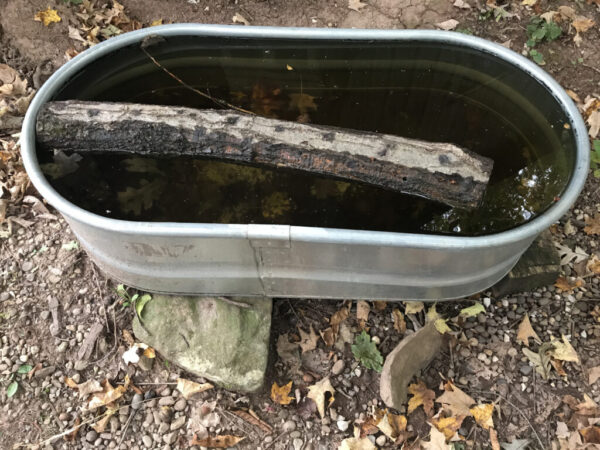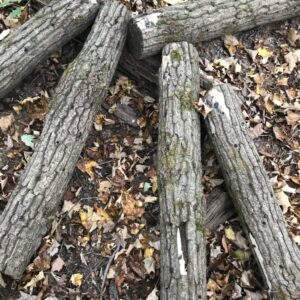- Like
- Digg
- Del
- Tumblr
- VKontakte
- Buffer
- Love This
- Odnoklassniki
- Meneame
- Blogger
- Amazon
- Yahoo Mail
- Gmail
- AOL
- Newsvine
- HackerNews
- Evernote
- MySpace
- Mail.ru
- Viadeo
- Line
- Comments
- Yummly
- SMS
- Viber
- Telegram
- Subscribe
- Skype
- Facebook Messenger
- Kakao
- LiveJournal
- Yammer
- Edgar
- Fintel
- Mix
- Instapaper
- Copy Link

A log inoculated with mushroom soaking in a tub of water.
A version of this column first ran in the Roane County (WV) Reporter and Times Record. Support local journalism! Subscribe to your local newspaper. This is one of a series of blogs for new gardeners. Start reading the whole series here: Part 1.
I only know of one kind of mushroom that grows well in a garden (winecaps), but since mushrooms are a food crop you can grow, I’m going to write about them. They have the virtue of making use of sites that are otherwise “wasted”—places in full shade. This could be a patch of woods near your house, but if you don’t have such a site, you can grow mushrooms under your porch—some people even grow them in basements.
I need to give a brief nod to the mushrooms you don’t cultivate. There are several wild species that make excellent eating, but this is a delicate subject because the consequences of misidentifying what you think is a good edible mushroom can be grave—pun intended. This is why every workshop and book on the subject includes the maxim, “There are old mushroom hunters and there are bold mushroom hunters, but there are no old, bold mushroom hunters.” Morels, AKA mollymoochers, are pretty safe, popping up mostly on ridges in April; you know about those, right? You may be familiar with the orange chanterelles of late summer; there are a few others but I will say no more, for fear of encouraging someone to take a chance.
You can buy mushroom spawn in various forms, for various edible species; I get mine from Field and Forest out of Wisconsin but there are other providers, including some of the seed catalogs. Most common are shiitakes grown on oak logs; I’ve done this several times with varying success. This is my primary choice because you can “force” the mushrooms to fruit by soaking the logs in water for a day or two—the summer varieties at least. I tried a cold weather variety once but won’t do it again because I find 90% of the mushrooms result from forcing. I should explain that the mycelium is the perennial part of the mushroom, in this case inhabiting the log (after you drill holes and insert spawn-impregnated wooden plugs or sawdust). The visible eruption of what we think of as “a mushroom” is the fruiting body. It makes spores to carry on its kind. Spores are the seeds of the fungi kingdom, though I suppose a biologist would screech in outrage at this inaccuracy.
Shiitakes may fruit for several years. I’ve also tried oyster mushrooms, which only fruit for about two years but can be quite prolific. I used the “totem method” for those the year I tried it; I plan to do it again next spring. As with shiitakes, you cut the logs in March or so and let them sit two to four weeks before inoculating them. You don’t want to let them go too long, or use unhealthy wood because you don’t want competing wild fungi. With the oysters you use soft hardwoods—around here that mostly means tulip poplar. Here’s how the totem method works: take a large plastic garbage bag and put a half inch layer of sawdust spawn in the bottom, followed by a chunk of poplar—I used pieces about fourteen inches in diameter and length. Stand one on top of the spawn, cover it with another layer of spawn, and then set another block of poplar on top of that. Top that with more spawn, and then fasten a paper grocery bag over the top (or newspapers if you can’t find a paper bag). Then tie the garbage bag loosely and store it for a couple of months at about room temperature, out of the sun and rain.
You should start to see the evidence of white mycelium colonizing the logs. Now you remove them from the bag and set them in the same kind of place your shiitake logs go—a shady woodland spot, maybe raised barely off the ground on small pieces of board. Different strains of oysters fruit at different temperatures.
In my experience the shiitakes always take at least a year to fruit, and then mainly do it when forced. It’s good to have a standard pattern of stacking or ordering your logs so you know which ones you have soaked recently and which are due next. It isn’t good to do the same log too often. Also, it’s important not to let the logs dry out. If you’re watering your garden, you should water your mushroom logs too. A watering can works nicely for this, and it helps, in the first year before fruiting especially, to spread an old, open weave cotton sheet or the like over the logs. This way when you soak it, the moisture remains for a long time and wind doesn’t dry out the logs.
As mentioned, you can order your spawn from garden catalogs, but Field and Forest specializes in mushrooms and has many experts on staff to answer your questions; you can also get a lot of information on their website. They sell various useful equipment as well as several kinds of spawn.
I will also mention that I rather easily dried some shiitake caps in a day or two in my greenhouse, but I prefer frozen mushrooms. Whenever you have more than you can use, lightly fry them in butter (perhaps with onions or garlic) and then freeze them. That way your time of excess can supply your time of dearth.
Read the rest: Part 1. Part 2. Part 3. Part 4. Part 5. Part 6. Part 7. Part 8. Part 9. Part 10. Part 11. Part 12. Part 13. Part 14. Part 15. Part 16. Part 17. Part 18. Part 19. Part 20. Part 21. Part 22. Part 23. Part 24.













